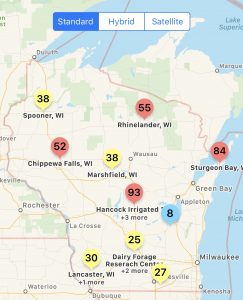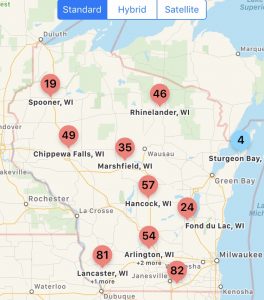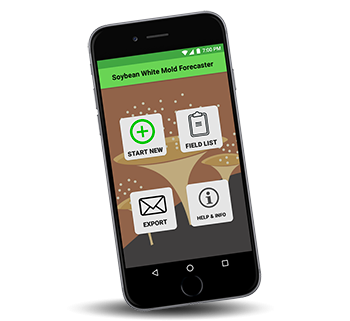Wisconsin Soybean White Mold Update – July 11, 2019

Figure 1. Sporecaster predictions for selected non-irrigated locations in Wisconsin for July 11, 2019.
Damon Smith, Extension Field Crops Pathologist, Department of Plant Pathology, University of Wisconsin-Madison
Shawn Conley, Extension Soybean and Small Grains Agronomist, Department of Agronomy, University of Wisconsin-Madison
Roger Schmidt, Nutrient and Pest Management Program, University of Wisconsin-Madison
Figure 1 illustrates the calculated risk of white mold for select Wisconsin locations for non-irrigated soybeans, as determined by Sporecaster for July 11, 2019. This means that if soybeans are flowering and the area between rows is filled in more than 50%, risk ranges from medium to high for the presence of apothecia and subsequent white mold development. Figure 2 illustrates calculated risk for the same locations for irrigated soybeans planted to 30-in row spacing. As you can imagine, risk is higher for irrigated soybeans planted to 15-in rows.
The UW Field Crops Pathology Team has started scouting white mold locations for apothecia. Overall, apothecia have not been observed at most locations, due to the fact that soybean canopies have not filled in to threshold. At only one location were we able to find apothecia and this location had met the canopy threshold. Remember, canopy closure is critical in calculating the probability of apothecial presence and subsequent white mold risk.
I’m Ready To Spray, What Should I use?

Figure 2. Sporecaster predictions for selected irrigated locations with soybeans planted to 30″ row-spacing in Wisconsin for July 11, 2019.
If the canopy has met threshold, soybeans are flowering, and your Sporecaster risk is high, then a fungicide might be warranted. If you have decided to spray soybeans for white mold, what are the best products to use? Over the last several years we have run numerous fungicide efficacy trials in Wisconsin and in conjunction with researchers in other states. In Wisconsin, we have observed that Endura applied at 8 oz at the R1 growth stage performs well. We have also observed that the fungicide Aproach applied at 9 fl oz at R1 and again at R3 also performs comparably to the Endura treatment. Other fungicide options also include Omega and Proline. You can view results of past fungicide evaluations for Wisconsin by CLICKING HERE. If you would like to run tailored estimations of return on investment for various fungicide programs, you can use another smartphone application called Sporebuster.
Helpful Smartphone Application Links
Sporecaster
- Click here to download the Android version of Sporecaster.
- Click here to download the iPhone version of Sporecaster.
- Here is a helpful video if you would like some tips on how to use Sporecaster. If you would like some advice on how to interpret the output, we have created an additional short video on this subject.
Sporebuster
- Click here to download the Android version of Sporebuster.
- Click here to download the iPhone version of Sporebuster.
- Here is a video on how to use Sporebuster and interpret the output.
Other White Mold Resources
- To watch an in-depth video on white mold management, CLICK HERE.
- To find more information and download a fact sheet on white mold from the Crop Protection Network, CLICK HERE.





